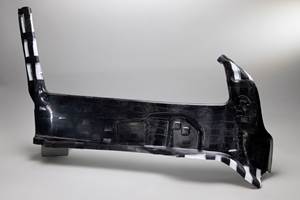AMRC adds 3D permeability measurement bench
The system is capable of measuring the permeability of a dry reinforcement, which is important for understanding how liquid resin will behave when injected in infusion and RTM processes.
The University of Sheffield Advanced Manufacturing Research Centre (AMRC, Sheffield, UK) has announced the addition of a 3D-permeability measurement bench to its diverse and growing portfolio of equipment. The new equipment was purchased with funding from the Aerospace Technology Institute (ATI,Cranfield, Bedfordshire, UK).
The EASYPERM permeability bench is manufactured by Institut de Soudure (Villepinte, France), an international technical center specializing in long fiber reinforced composites, and allows for the standardization of testing.
The system is capable of measuring the permeability of a dry reinforcement, which is important for understanding how liquid resin will behave when injected in infusion and RTM processes.
Steffan Lea, a research fellow at the AMRC Composite Centre, says, “What we get at the end is a measurement – a number that can be used in simulations that take a couple of minutes rather than several hours compared with if we were using other methods. By using sub-scale (coupons and computer simulation) testing to provide fast and accurate data, it cuts down on a trial and error approach, saving our research partners money, material and time.”
The system allows for the characterization of resin flow in dry fiber reinforcements – crucial information for performing simulations of large and complex parts, and also for process optimization in high production rates. It can be used to characterize all types of fiber including glass, carbon, aramid, flax and hemp and requires a minimal amount of material to perform the evaluation.
“Some of the key technical capabilities of the machine is that is has two configurations for permeability measurement – in-plane and through-thickness,” says Lea. “It has up to five bar injection pressure and is coupon scale so you’re not wasting lots of material while you’re doing the testing, making efficient use of test material. It also works with any kind of fiber and the chamber is adjustable so we can vary the fiber volume fraction.”
The permeability bench has already been used on projects including testing for GE Aviation’s Digital Propulsion project and FabForm, a project for a textile manufacturer looking at the stabilization of thick 3D woven fabric to create composite preforms for automotive and aerospace.
Lea explains how the machine works:
“Under the lid is a test chamber, inside which goes the test material – the coupon. You close the lid and inject a model fluid to replicate the resin – we use rapeseed oil - and as the pressure sensors inside the chamber are triggered, you can see how the oil flows through the material – so whether it flows in one direction more than another.
“A key factor for us is that EASYPERM is a commercially available piece of equipment so we can compare our results to others using the same methods and have certainty that the test is being conducted in a consistent manner. It is standardizing testing.
“In composites, there is a tendency for people to develop their own in-house way of testing but with this it is standardized. What that means is that if a university in Australia for example has the same equipment, we could compare our results with theirs, whereas before we would have to get our own material and do the tests in our own way.”
The new stable of ATI-funded equipment, which includes a braiding system, Jacquard loom, tailored fiber placement, a high temperature, high tension filament winder, tow-spreading machine and robotic end effectors for automated handling, will be used to not only manufacture preforms but also develop enabling technology for commercialization including joining, automation and impregnation. Research undertaken with this equipment by the AMRC aims to bring down the cost of complex composite components.
Related Content
3D-woven composites find success in aerospace, space
CAMX 2024: Bally Ribbon Mills experts are displaying the company’s various joints, thermal protection system (TPS) technologies and other 3D woven composites for mission-critical applications.
Read MoreTechnical textiles, prepregs, composite parts and multilayered materials
CAMX 2025: BGF Industries is highlighting its range of versatile woven products for composite reinforcements, with materials, parts and literature available for viewing, as well as those from parent company Porscher Industries.
Read MoreHighly tunable, woven lattice reinforcements target automotive structures
CAMX 2023: Startup Weav3D will be demonstrating its two collaborative automotive demonstrator parts and present two conference papers.
Read MoreWoven UD fabric enhances scalable carbon fiber options for infrastructure
CAMX 2025: Zoltek introduces PX35 woven UD fabric which bridges the gap between performance and affordability for retrofit and new build scenarios.
Read MoreRead Next
Cutting 100 pounds, certification time for the X-59 nose cone
Swift Engineering used HyperX software to remove 100 pounds from 38-foot graphite/epoxy cored nose cone for X-59 supersonic aircraft.
Read MoreNext-gen fan blades: Hybrid twin RTM, printed sensors, laser shock disassembly
MORPHO project demonstrates blade with 20% faster RTM cure cycle, uses AI-based monitoring for improved maintenance/life cycle management and proves laser shock disassembly for recycling.
Read MoreUltrasonic welding for in-space manufacturing of CFRTP
Agile Ultrasonics and NASA trial robotic-compatible carbon fiber-reinforced thermoplastic ultrasonic welding technology for space structures.
Read More












